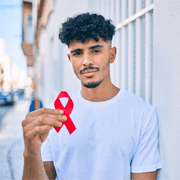SAFE SEX - How to Have Safe Sex
In This Article
SAFE SEX - How to Have Safe Sex
Alex
Updated on November 03, 2023
Medically verified by Dr. Arya
Fact checked by Dr. Sharon

Wellness
11 min read
While intimacy is a beautiful and natural part of life, it can come with risks. If not approached responsibly.
Many people are uncertain about the best practices for safe sex. Leading to unnecessary anxiety and potential health consequences.
The question is, do you have all the information you need to ensure your sexual life is as safe as possible? Are you aware of the risks and the steps you can take to mitigate them?
If you don't have all the answers, you're not alone. Safe sex can be confusing, especially in a world where information is abundant but not always accurate.
Your well-being matters, and you should know how to protect yourself and your partner. We're here to provide clarity and guidance, so you can enjoy intimacy with confidence and peace of mind.
Understanding the Importance of Safe Sex
Before we get into the details, let's talk about why safe sex matters.
Safe sex isn't just about preventing pregnancy. It's also about protecting yourself and your partner from sexually transmitted infections (STIs). These infections can have serious health consequences, and some of them are lifelong.
1. Condoms Are Your Best Friend: One of the most effective ways to practise safe sex is by using condoms. They create a barrier that prevents the exchange of bodily fluids, reducing the risk of both pregnancy and STIs. Condoms are easily available, affordable, and easy to use.
2. Consent Is Key: Before we dive deeper into the mechanics of safe sex, let's talk about consent. Consent means that all parties involved willingly agree to engage in sexual activity. It's an absolute must for any sexual encounter. Always make sure everyone is on the same page and feels comfortable and safe.
Condoms: Your Shield Against STIs and Unplanned Pregnancy
Now, let's talk about condoms - your trusty sidekick in the world of safe sex.
Choosing the Right Condom
Not all condoms are created equal. It's important to find the one that works best for you. Here are some things to consider:
| Material | Size | Texture |
|---|---|---|
| Condoms come in various materials, such as latex, polyurethane, and polyisoprene. Latex condoms are the most common and provide excellent protection against both pregnancy and STIs. However, if you or your partner is allergic to latex, non-latex options are available. | Condoms come in different sizes to ensure a snug and comfortable fit. Trying out a few different sizes can help you find the one that works best for you. | Some condoms come with textured surfaces for added stimulation. While these can enhance pleasure for some, they might not be suitable for others. Experiment to find what suits you and your partner best. |
Proper Condom Use
Now, let's talk about the right way to use condoms. It's essential to follow these steps every time:
1. Check the Expiration Date: Before opening the condom wrapper, check the expiration date. Using an expired condom can compromise its effectiveness.
2. Open Carefully: Gently tear open the wrapper, being careful not to damage the condom inside.
3. Pinch the Tip: After unrolling the condom slightly, pinch the tip to leave some space for semen. This step prevents the condom from bursting during ejaculation.
4. Roll it Down: Unroll the condom all the way down the shaft of the erect penis or onto a sex toy. Make sure it covers the entire length.
5. After Sex: After ejaculation, hold the base of the condom and carefully withdraw to prevent any spillage.
6. Dispose of Properly: Tie a knot at the open end of the condom and dispose of it in the trash. Do not flush condoms down the toilet.
Types of Condoms
As we discussed, condoms are a type of barrier contraception; fundamentally, they work to reduce the risk of STIs by preventing sperm from entering the vagina, mouth, or anus.
There are different types of condoms:
Male condoms (external): Male condoms are available in a variety of sizes and shapes. They are made of a thin, tough latex (rubber) pouch. For those who are allergic to latex, there are condoms made of non-latex materials.
Female condoms (internal): Female condoms are flexible rings on each end of a soft synthetic rubber pouch that resembles an exterior condom. These condoms are made to fit into the vagina or anus and are available in one size and pre-lubricated.
Diaphragms: A soft, shallow silicone cup called a diaphragm covers the cervix, which is the opening to the uterus or womb, and fits into the vagina. Although they offer effective protection against pregnancy, diaphragms do not shield you against STIs.
Additional Tips
Here are a few extra tips for condom use:
- Use only water-based or silicone-based lubricants with latex condoms. Oil-based lubricants can weaken latex and make it more likely to break.
- Keep condoms in a cool, dry place, away from direct sunlight or extreme temperatures.
- Always have a backup supply of condoms on hand. You never know when you might need them.
Also read : How to avoid pregnancy
Birth Control Options
While condoms are an excellent choice for preventing both pregnancy and STIs, there are other birth control options available for those who want added protection against unplanned pregnancy.
1. Birth Control Pills: These are taken daily and are highly effective at preventing pregnancy. However, they do not protect against STIs.
2. Intrauterine Devices (IUDs): IUDs are small, T-shaped devices that are inserted into the uterus by a doctor. They provide long-term contraception and do not protect against STIs.
3. Birth Control Implants: These are small rods placed under the skin of the upper arm. They provide long-term contraception and, like IUDs, do not protect against STIs.
4. Depo-Provera Shot: This is an injection of progestin that provides protection against pregnancy for three months. It also does not protect against STIs.
5. Emergency Contraception: Sometimes, accidents happen. Emergency contraception pills can be taken within 72 hours (or up to 120 hours, depending on the type) after unprotected sex to reduce the risk of pregnancy.
STIs: Know Your Risks and Get Tested
Sexually transmitted diseases (STDs), also called sexually transmitted infections (STIs), are infections that can spread through sex. They can affect anyone, no matter how old you are, your gender, or who you're attracted to. Knowing about STDs and how to stay safe during sex is very important.
Common STIs and Symptoms
| STI | Symptoms |
|---|---|
| Chlamydia | Often symptomless, but it can cause pain during urination and unusual discharge. |
| Gonorrhoea | May lead to painful urination, abnormal discharge, and pelvic pain. |
| Syphilis | Early symptoms include sores or rashes; untreated, it can affect organs. |
| Herpes | Causes painful genital or oral sores, even without visible symptoms. |
| HIV/AIDS | Early symptoms resemble the flu, but it can progress to weaken the immune system. |
| HPV | Can cause genital warts and various cancers, often symptomless. |
| Hepatitis B and C | May lead to jaundice, fatigue, and abdominal pain. |
 7 min read
7 min readPhysical Fitness and Sexual Health: How Exercise Boosts Your Sexual Life
 7 min read
7 min readSexually Transmitted Diseases: Types, Symptoms, Treatment
 14 min read
14 min readHow to Avoid Pregnancy After Sex
Get a Callback Now
Key Steps for STI Protection
Safe sex isn't just about preventing pregnancy; it's also about protecting yourself and your partner from sexually transmitted infections (STIs). Here are some key points to remember:
1. Know Your Partner's Status: Before engaging in sexual activity, have an open and honest conversation with your partner about their sexual health. Knowing your partner's STI status is crucial for making informed decisions.
2. Get Tested Regularly: Both you and your partner should get tested for STIs regularly, even if you feel fine. Many STIs are asymptomatic, meaning you may not show any symptoms but can still transmit the infection. Regular testing helps detect and treat STIs early.
3. Use Barrier Methods: Condoms provide a strong barrier against most STIs. However, they may not provide complete protection against skin-to-skin infections like herpes and genital warts. In such cases, it's essential to use condoms in conjunction with regular testing and communication with your partner.
Communicate and Build Trust
Open communication with your partner is a cornerstone of safe sex. It's important to discuss your sexual health, boundaries, and desires. Here's how you can do it:
1. Have "The Talk": Before engaging in sexual activity with a new partner, have a candid conversation about your sexual history, STI status, and contraception preferences.
2. Respect Boundaries: Always respect your partner's boundaries and communicate your own. Consent is an ongoing process, and either party can withdraw it at any time.
3. Build Trust: Trust is essential in any sexual relationship. Building trust comes from open and honest communication, being respectful, and making your partner feel safe and valued.
Treatment and Care
If you test positive:
- Seek prompt treatment with antibiotics or antivirals.
- Early treatment reduces complications and prevents transmission.
- Remember, STIs can happen to anyone; seeking treatment is responsible and vital for sexual health.
Take control of your sexual health with awareness, safe practices, and regular testing. Your health matters!
Safe Sex Beyond Heterosexual Relationships
It's important to note that safe sex is not limited to heterosexual relationships. LGBTQ+ individuals also need to practise safe sex to protect themselves and their partners. The same principles of using protection, getting tested, and having open communication apply to all relationships.
LGBTQ+ Safe Sex Tips
1. Use Barrier Methods: Regardless of your sexual orientation, using condoms and dental dams for oral, anal, and vaginal sex is essential for preventing both pregnancy and STIs.
2. Regular Testing: Get tested regularly for STIs, especially if you have multiple partners or engage in high-risk sexual activities.
3. PrEP and PEP: Pre-exposure prophylaxis (PrEP) is a daily medication that can reduce the risk of HIV transmission. Post-exposure prophylaxis (PEP) is a treatment taken after potential exposure to HIV. These options are available for individuals at higher risk.
Safe Sex and Alcohol or Drugs
Sometimes, people make choices about sex while under the influence of alcohol or drugs. It's crucial to remember that substances can impair judgement and decision-making, increasing the risk of unprotected sex and risky sexual behaviours.
1. Plan Ahead: If you anticipate engaging in sexual activity while under the influence, plan ahead. Ensure you have condoms and other protection methods readily available.
2. Buddy System: Use the buddy system and look out for your friends. Make sure they are also practising safe sex if they're sexually active.
3. Consent Is Still Vital: No matter the circumstances, consent remains essential. Being under the influence does not excuse non-consensual actions.
Safe Sex Tips
Avoid having sexual activity when drunk or using drugs.
It is best to avoid having several sexual partners. With a long-term committed partner, it is safer to engage in sex. Still, it is always advisable that you use a condom.
Preferably until late adolescence or the early 20s, wait to engage in early sexual activity until the reproductive system is completely matured.
It is advised to shower twice daily if you reside in a tropical climate. Maintaining your sexual health also heavily depends on your personal cleanliness.
STIs can also be transferred through sexual acts other than penis to vagina contact. It's crucial to use additional barrier protection methods. Any STI can be communicated by mouth to genital, hand to genital, hand to anus, or hand to anus sexual contact.
Safe Sex is Self-Care
Safe sex is an essential aspect of self-care and a responsible approach to sexual relationships. It's about protecting your health and the health of your partner while enjoying a fulfilling sex life. Remember these key points:
- Condoms are a reliable form of protection against both pregnancy and STIs.
- Communication and trust with your partner are fundamental.
- Regular testing for STIs is a responsible practice.
- Safe sex applies to all sexual orientations and genders.
- Alcohol and drugs can impair judgement, so plan ahead.
So, my friend, embrace the power of safe sex in your life. It's a simple yet crucial step toward a healthier, more enjoyable, and worry-free sexual experience. Take care of yourself and your partner(s), and remember, there's no shame in prioritising your sexual health. Stay safe, stay responsible, and enjoy your intimate moments to the fullest!
Also read : Sex without protection
Your Well-being Matters: Remember, safe sex isn't just about avoiding pregnancy; it's also about looking out for yourself and your partner's health. So, let's dive in and make sure you've got the lowdown on safe sex!
Condoms Are Your Besties: Condoms are like your trusty sidekicks in the world of safe sex. They're affordable, easy to find, and they've got your back when it comes to preventing both pregnancy and STIs.
Consent Is a Must: Consent is super important.. Make sure everyone's on board and feeling comfortable.
Know Your STIs: Don't be in the dark about sexually transmitted infections (STIs).
Use the Right Condom: Not all condoms are the same. Choose the one that's right for you.
Other Birth Control Options: Condoms are awesome, but there are other birth control methods out there.
Know Your Partner's Status: Communication is key! Talk openly with your partner about their sexual health and get tested regularly. It's all about making informed choices.
LGBTQ+ Safe Sex: Safe sex isn't just for one group; it's for everyone. LGBTQ+ individuals can also stay protected by using barrier methods and getting tested regularly.
Watch Out for Alcohol and Drugs: Sometimes, a night out can lead to unexpected situations. Stay prepared, look out for friends, and remember that consent is a must, even when you've had a drink or two.
Safe Sex = Self-Care: In the end, safe sex is all about taking care of yourself and your partner while having a good time. Prioritise your health, communicate openly, and enjoy those intimate moments with confidence. You've got this! Stay safe, stay respo
Source Links
Condoms : Your contraception guide
Birth control
Planned Parenthood
National Library Of Health



